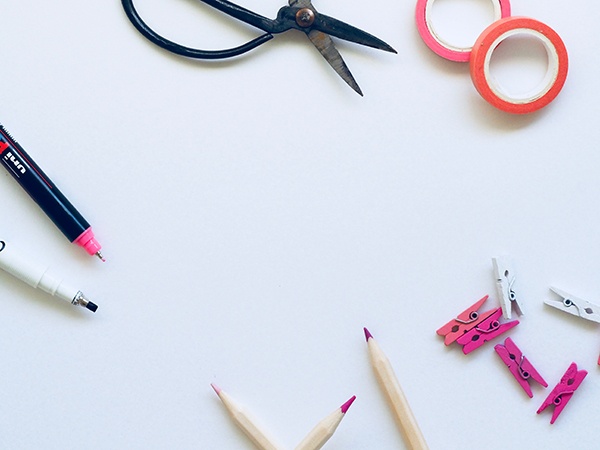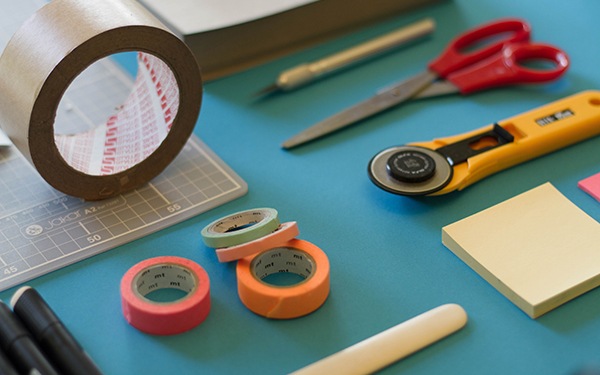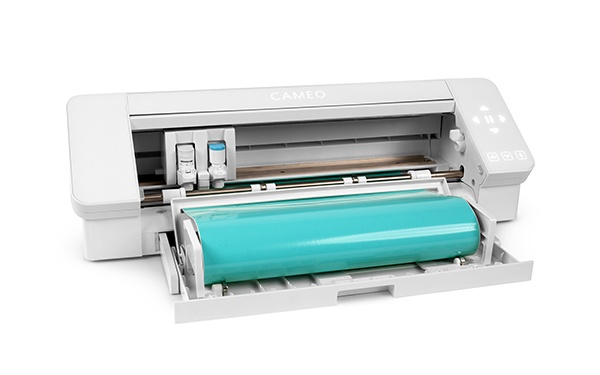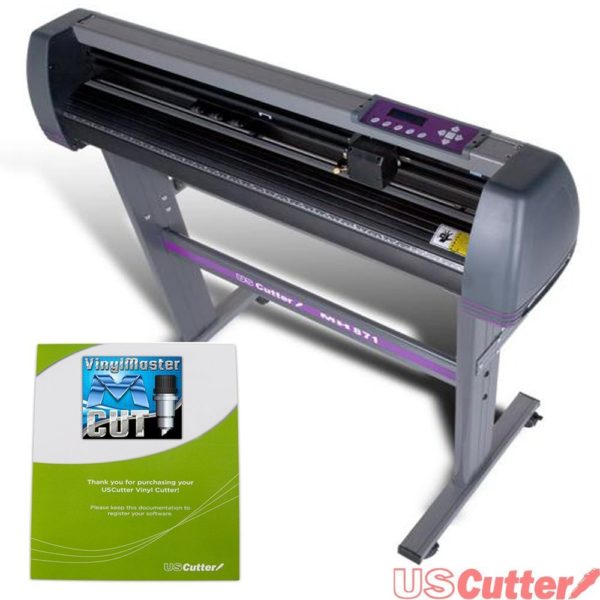Are you looking for the best cutting machine for your craft business? We’ve got you covered.
Buying the best vinyl cutting machine is one of the most important investments you’ll make when establishing your business. No matter how good your ideas are, if your machine can’t execute them to a professional standard, you’re not going to get anywhere.
Of course, it’s not just a case of simply buying the ‘best’ cutter — you’ll need to find the one that’s best for your particular circumstances and business.
There’s lots to consider — but that’s where we come in.
We’ve compiled this comprehensive guide to what you need to be looking for and the best cutting machines on the market right now for craft businesses.
Here’s a sneak peek of our favorite business cutters:
Let’s get straight into it…
Post Contents
What Type of Cutting Machine Do I Need for a Craft Business?
If you’ve had even a brief look at our guide to the best vinyl cutting machines, you’ll know that there are a lot of craft cutters on the market.
But the truth is that most of these will not be well suited to running a craft business.
We’ll be running through the features of the best craft cutters for business shortly, but essentially you’ll be looking at the top tier of personal machines and even commercial style cutters if you’re taking your business seriously.
Manual cutting machines with a hand crank (we’re looking at you Sizzix Big Shot and Cricut Cuttlebug) are unlikely to be able to compete against their sleeker electronic counterparts. This isn’t because they’re bad machines by any stretch — just that they’re not in the same league when it comes to accuracy and efficiency.
Personal vs Commercial Cutters
Generally speaking, the cutting machines that are going to be best suited to running a craft business are going to be commercial level cutting machines.
These machines embody what most of us are looking for in a craft cutter:
- Highly accurate
- Efficient and quick working
- Powerful
- Versatile
But they do have some less positive features in comparison to most personal machines to consider before you buy:
- More expensive
- Often much bigger
- Not as user-friendly with a steeper learning curve
- Sometimes require expert maintenance
Personal craft cutters, on the other hand, are generally much more user friendly but better suited to hobbyist projects as they can lack in accuracy and efficiency — let alone cutting size.
But there is a new generation of cutting machines that are bridging the gap and blurring the lines between personal and commercial machines that seem to embody the best of both worlds.
You’ll find a few of these on our list below — brands moving in this direction include Cricut, Silhouette and KnK.
Features of the Best Craft Cutters for Business
When you’re launching a brand new craft business, your priority should be providing your customers with the best possible variation of your products.
And what’s going to get you there?
The best cutting machine.
Exactly what makes the ‘best’ cutter will vary from person to person and business to business, but there are some features that will be common across every crafter’s wish list.
Let’s take a look…
Electronic
We’ve already touched on the fact that you’re going to need an electronic cutter rather than a manual one if you’re running a craft business.
Manual die cutters like the Big Shot certainly have a lot going for them, but the truth is that they can’t consistently deliver on quality like an electronic machine can.
There’s much less room to go wrong with an electronic machine — not to mention your arm won’t get sore after using that hand crank all day!
Manual cutters aren’t made for efficiency and accuracy, especially when you’re churning designs out in high numbers.
There may be a few people who still use their manual cutter when running their business, but we guarantee that they’re an exception to the rule.
It’s always worth spending a little more money to get an electronic machine.
Accuracy
Hand-in-hand with having an electronic machine is the need for accuracy.
We all like our cuts to look flawless and exactly what we’ve designed in the software, so it’s important to choose a cutter that prioritizes accuracy.
Particularly if you intend on cutting complex designs.
Every cutting machine will shout about how accurately it cuts so it’s important to read impartial reviews from other crafters to get the real low-down on this.
Commercial cutters are particularly well known for their accuracy thanks to in-built calibration devices like registration tracking systems and sophisticated communication signals between the cutter and your software.
We’re seeing more of this with personal machines as well nowadays so you don’t need to spend a fortune to guarantee accuracy.
Also worth considering is the quality of the blades used in the machines as this can play a huge part in how accurately the cutter performs. Cricut, for instance, use premium German carbide blades that always ensures a smooth and accurate cutting experience.
Just remember to replace your blades frequently to avoid them becoming dull and choppy!
Speed
As your craft business picks up pace, you’ll become increasingly concerned with the efficiency of your machine.
You want something that isn’t only accurate but can keep up with the speed of your orders too. This will be particularly important come the holiday season when orders start piling up!
We’ve seen companies like Silhouette and Cricut invest a lot in their latest machines so they can cut at double and even triple the pace of their previous cutters.
Of course, the fastest machines are generally commercial cutters which are sometimes specially designed to work on multiple cuts at once or just at lightening speed.
How fast you need your machine to be will depend on how many orders you can imagine taking on at once and how much time you have to spare for the actual cutting process.
If you’re planning to sell a high volume of vinyl decals for instance, you’ll probably want to prioritize a machine that can work super fast. But if your products are more complex, like t-shirts for instance, you’ll be able to spare more time for cutting as you’ll be working on other aspects of the product while your machine cuts.
Versatility
One way that personal machines often out-perform commercial cutters is in terms of versatility.
By their very nature, commercial cutters are often designed to perform one job. Now, they’ll perform that one job very well, but they can be a little lacking when it comes to using different materials especially.
The best personal cutting machines, on the other hand, have really emphasized versatility especially.
The best on the market can effectively work with hundreds of different materials of different thicknesses and density with no problem at all. They often have multiple different tools and blades available to complete different tasks.
The Cricut Maker is probably one of the best examples of this — it can cut fabric like butter as well as materials like leather and chipboard — not to mention all the usual materials like paper, cardboard and vinyl.
Previously, you would have had to buy three different machines to accomplish what can now be done with just one — a personal cutter, a commercial cutter capable of taking on thick materials and a specialist fabric cutter.
Just how versatile you need your cutting machine will again depend on the needs of your business and what you imagine for the future — will you be happy just making the same sort of creations over and over, or do you require a machine that can grow with your imagination and business interests?
Things to Consider Before Buying
Budget
Budget is probably the number one consideration when it comes to buying a cutting machine for your craft machine.
Most of us start our businesses on a shoestring — it’s important to keep cuts reasonably low until you start consistently cutting a profit.
But there’s definitely a balance to be struck — as with most things in life, you get what you pay for with cutting machines.
The cheapest machines — say those under $150 — often just aren’t equipped to perform at a business level. They more than likely suffer in one of those key features — accuracy, speed and versatility.
Commercial cutters, on the other hand, can easily cost around $1,000 which is a huge outlay — especially when you’re first starting out.
Thankfully, there is a middle ground — the cutters that lie somewhere between personal and commercial are generally priced somewhere between $300-$500, which is much easier to swallow.
Remember, a cutting machine is an investment for both you and your craft business. Think carefully about what you can afford to spend and how a slightly more expensive cutter might benefit you.
Software
One of the biggest bugbears for crafters working with cutting machines is the quality of the software that comes with the machine.
Needless to say, there’s a huge difference from program to program, and what you like will likely be different to what I like as it’s such a personal preference.
Presumably, you already have a preference for certain software if you’re thinking about launching a cutting business.
We tend to categorize software programs 3 ways:
- Best for beginners with a gentle learning curve — Silhouette Studio, Cricut Design Space
- Best for the middle ground, easy to get to grips with when you have some experience and a good place to grow your design skills — Sure Cuts A Lot, Make The Cut
- Best for experts, likely requires some training to use effectively but offers the most scope for designers — Adobe Illustrator, Corel Draw
There are other software programs, but these 6 are the most prevalent in the craft cutting industry.
Consider carefully what software you are most likely to use in your business before you buy a machine.
There’s not much point buying a commercial cutter with Adobe Illustrator if you’d rather work in Silhouette Studio, for instance.
Remember that programs like Sure Cuts A Lot, Make The Cut, Adobe Illustrator and Corel Draw are often compatible (or can be made to be compatible) with lots of different machines although you will likely have to upload designs from there into the proprietary programs.
Size
There are two different things we mean by size:
- The maximum cutting size of the machine
- How much physical space the machine takes up
Number 1 is very important for craft businesses.
Most personal cutting machines are restricted in that their maximum cutting sizes are often on the small sides. Cricut machines, for instance, can only cut designs up to 11.5″ wide and 23.5″ long.
If you generally only make smaller designs this is unlikely to be a problem for you but may be worth considering if you ever plan to sell larger designs.
Commercial cutters are generally your best bet if you’re looking for a large maximum cutting size — for car decals, for example.
Having said that, some personal machines are available in slightly larger sizes — the USCutter, Silhouette Cameo 4, and KnK Zing Orbit for starters.
Number 2 is also worth considering, especially if you plan to conduct your business in a very small space.
If that sounds like your circumstances, you’ll likely want to opt for a smaller desktop cutter with a smaller footprint. If you’ve got more room to play with, then feel free to consider larger freestanding cutters and commercial machines.
Best Cutting Machines for Craft Businesses
The Cricut Maker is one of the cutting machines that has effectively bridged the divide between personal and commercial cutters.
It is supremely versatile, more than any other machine we can think of on the market right now.
What can’t it cut? Er… there’s not much.
It can cut hundreds of different materials, including unbonded fabric (with the Rotary Blade) and materials up to 2.4 mm thick (with the Knife Blade).
That’s not the only thing going for it though — it’s an excellent, precision cutter thanks to its premium blades that can handle the majority of work for most craft businesses.
Where it might fail you is in its cutting size — a maximum width of 11.5″ and length of 23.5″ — and in the proprietary software Cricut Design Space that is best suited to hobbyist beginners. You can hook it up with better software though with some extra tweaks.
- Versatile in the extreme
- Access to a huge sewing pattern library
- Great cutter
- Comes with the Fine Point Blade, Rotary Blade and a variety of cutting mats
- Compatible with all past, present and future Cricut tools
- Excellent price
- Small maximum cut size
- Cricut Design Space may be a tad limiting for some crafters
The Cameo 4 is the latest release from cutting behemoth Silhouette and is currently lighting up the whole of the craft cutting world.
Similar to the Cricut Maker in many ways, the Cameo 4 has some significant advantages for those looking to start up a cutting business:
- Built-in roll feeder ideal for cutting large batches quickly
- Will be available in three sizes: 12″, 15″ and 20″ cutting widths
- 5kg of downward force
Considering its excellent price, this is a very popular choice with crafters who are launching their own businesses — it’s a professional machine for an amateur price.
- Fantastic price
- As powerful as most commercial cutting machines
- Can cut larger sizes than most desktop cutters
- Easy to use
- Versatile
- 3 times faster at cutting than its predecessor, the Cameo 3
- Built-in roll feeder and cross cutter means maximum efficiency when cutting
- Matless cutting availbale
- It’s new so we’re still awaiting the brand new tools and larger size models
- Not everyone loves working with Silhouette Studio
Another hugely popular vinyl cutter is the US Cutter MH 34.
Where this bad boy really stands out is in the size stakes — it offers a 34″ wide feed and 30″ cut width. This really leaves the other personal vinyl cutters trailing behind in the dust.
Another reason for its popularity is that it’s available for a very low price in comparison with other personal cutters and similarly sized commercial ones.
So if you work on lots of larger products — car vinyl designs, for instance — you may find that the USCutter MH 34 is the cutter for you. Particularly if you’re also buying on a budget.
It’s not perfect by any stretch — it’s best when it’s tasked with simple cuts on simple materials — but for many businesses it should be perfectly sufficient.
- Huge maximum cut size
- Excellent low price
- VinylMaster Cut software is included free
- Can work with other popular software, like Sure Cuts A Lot
- Reasonably sturdy and durable
- Easy to use
- A competent cutter with simplistic cuts
- Good for beginners and those just starting out
- Excellent bundle deal with additional tools
- Not compatible with Mac computers
- Doesn’t perform as well on complex designs
- Large and heavy
The Graphtec CE6000 series are definitely our favorite commercial cutting machines on the market.
Sure, they’re expensive, but it’s rare to find any other cutter that can deliver professional results like this bad boy.
Speed and accuracy are its main draws, thanks to the Automatic Registration Mark Sensor and servo motor that works like nothing else we’ve seen.
Small businesses specializing in signage or car decals will likely be the most obvious customers for the Graphtec CE6000.
This particular model is the CE6000-60, but there are a number of other models that can cut different material widths — up to 48″ with the CE6000-120 and down to 15″ with the CE6000-40.
There’s a steep learning curve when it comes to mastering the Graphtec, but it does pay off if you’re willing to put in the time and money investment.
- Highly accurate regardless of design complexity
- High speed, reliable servo motor
- Can cut large projects
- Can work with a variety of different software programs
- Highly efficient and keeps material wastage low
- Bundle comes with design software and Oracal 651 vinyl
- 2 year warranty available
- Different sizes available depending on your needs
- Expensive
- Not hugely versatile — it specializes in all types of vinyl
The next Graphtec model up — the FC8600 — is really the pinnacle of commercial cutting.
This should be at the top of your wish list if you’re looking for a commercial cutting machine that will produce professional results, be able to churn out cuts like an absolute workhorse and put you playing among the big boys.
It’s available in 5 different sizes that can cut widths of 24″ up to a whopping 64″. It also cuts insanely quickly — 58.5 inches per second, to be precise.
If you’re running a large scale vinyl cutting business that requires power, size and accuracy from its machinery, the Graphtec FC8600 is definitely the machine for you.
But if you thought the CE6000 was expensive, you’re probably going to want to sit down before you add the FC8600 to your cart.
We’d definitely recommend viewing this one as a business expense!
- There’s no commercial vinyl cutter better for producing professional results
- Highly accurate — even more so than the CE6000 thanks to the Intelligent Scan Mode
- Insanely fast thanks to the servo motor
- Quiet operation (especially considering the speed!)
- No tearing thanks to tangential emulation
- Highly efficient and very little waste created
- Excellent contour cutter
- Can work with a variety of different software programs
- Very heavy duty
- Can handle lots of different materials
- Very expensive
- Large and heavy
Are you considering launching a craft business?
Make sure you check out our comprehensive 130+ page guide ‘How To Launch A Successful Vinyl Cutting Business
It includes everything you need to know to launch your own vinyl cutting business and start making sales today
Find out what really works, and what doesn’t in 2019 — how can you come up with design ideas that your audience will love, and pay you for?
So those are our picks for the best cutting machines for business. Which is your favorite?
For more tips and ideas on making money from crafts, check out our Craft Business section.









